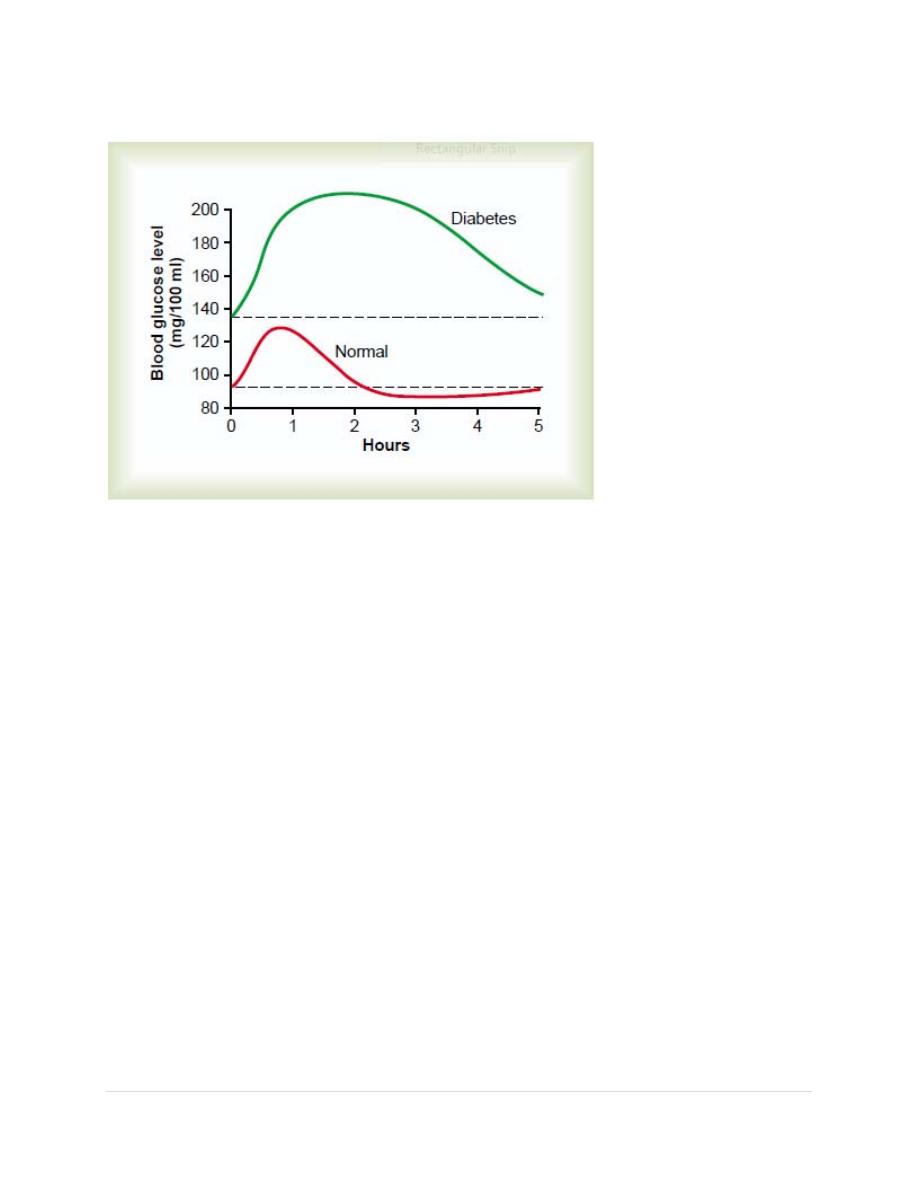
1 |
P a g e
Dr.HANAN AL‐TAEE
DEPARTMENT OF PHYSIOLOGY
APPLIED PHYSIOLOGY
Diabetes Mellitus
Diabetes mellitus is a metabolic disorder characterized by high blood glucose level, associated
with other manifestations. ‘Diabetes’ means ‘polyuria’ and ‘mellitus’ means ‘honey’. The name
‘diabetes mellitus’ was coined by Thomas Willis, who discovered sweetness of urine from
diabetics in 1675. In most of the cases, the cause of clinical diabetes is always: a deficiency of
the effects of insulin at the tissue level caused by either lack of insulin secretion or decreased
sensitivity of the tissues to insulin., leading to:
1. Reduced entry of glucose into various “peripheral” tissues.
2. Increased liberation of glucose into the circulation from the liver.
Therefore there is an extracellular glucose excess and, in many cells, an intracellular glucose
deficiency—a situation that has been called “starvation in the midst of plenty. The entry of
amino acids into muscle is decreased and lipolysis is increased.
There are several forms of diabetes mellitus, which occur due to different causes. Diabetes may
be primary or secondary. Primary diabetes is unrelated to another disease. Secondary diabetes
occurs due to damage or disease of pancreas by another disease or factor.
Recent classification divides primary diabetes mellitus into two types, Type I and Type II.
Type 1 diabetes, or insulin‐ dependent diabetes mellitus (IDDM):
Is due to insulin deficiency caused by destruction of the B cells in the pancreatic islets,
and it accounts for 3–5% of cases and usually presents in children (autoimmune, viral
infection, hereditary).
It usually occurs before 40 years of age
The persons affected by this require insulin injection. So it is also called insulin‐
dependent diabetes mellitus (IDDM).
When it develops at infancy or childhood, it is called juvenile diabetes.

2 |
P a g e
Type 2 diabetes, or non‐insulin‐dependent diabetes mellitus (NIDDM),
Is characterized by the dysregulation of insulin release from the B cells, along with
insulin resistance in peripheral tissues such as skeletal muscle, brain, and liver.
Usually presents in overweight or obese adults.
Account 90% of diabetic patients.
It usually occurs after 40 years.
In most cases, it can be controlled by oral hypoglycemic drugs. So it is also called
noninsulindependent diabetes mellitus (NIDDM).
Following are the signs and symptoms of diabetes mellitus:
1. Glucosuria
Glucosuria is the loss of glucose in urine. Normally, glucose does not appear in urine. When
glucose level rises above 180 mg/dL in blood, glucose appears in urine. It is the renal threshold
level for glucose.
2. Osmotic diuresis
Osmotic diuresis is the diuresis caused by osmotic effects. Excess glucose in the renal tubules
develops osmotic effect. Osmotic effect decreases the reabsorption of water from renal
tubules, resulting in diuresis. It leads to polyuria and polydipsia.
5. Polyphagia
Polyphagia means the intake of excess food.
6. Asthenia
Loss of strength is called asthenia. Asthenia occurs due to protein depletion, which is caused by
lack of insulin.
7. Acidosis
8. Acetone breathing
In cases of severe ketoacidosis, acetone is expired in the expiratory air, giving the characteristic
acetone or fruity breath odor. It is a life‐threatening condition of severe diabetes.
9. Kussmaul breathing
Kussmaul breathing is the increase in rate and depth of respiration caused by severe acidosis.

3 |
P a g e
10. Circulatory shock
Osmotic diuresis leads to dehydration, which causes circulatory shock. It occurs only in severe
diabetes.
11. Coma
Due to Kussmaul breathing, large amount of carbon dioxide is lost during expiration causing
severe acidosis and coma. It occurs in severe cases of diabetes mellitus. Also increase in the
blood glucose level develops hyperosmolarity of plasma which also leads to coma. It is called
hyperosmolar coma.
Complications of Diabetes Mellitus
Prolonged hyperglycemia in diabetes mellitus causes dysfunction and injury of many tissues,
resulting in some complications. Development of these complications is directly proportional to
the degree and duration of hyperglycemia.
The precise mechanisms that cause tissue injury in diabetes are not well understood but
probably involve multiple effects of high glucose concentrations and other metabolic
abnormalities on proteins of endothelial and vascular smooth muscle cells, as well as other
tissues. Vascular complications and atherosclerosis are responsible for the development of
most of the complications of diabetes
These complications are:
1. Cardiovascular complications like:
i. Hypertension
ii. Myocardial infarction
2. Degenerative changes in retina called diabetic retinopathy
3. Degenerative changes in kidney known as diabetic nephropathy
4. Degeneration of autonomic and peripheral nerves called diabetic neuropathy.
Diagnostic Tests for Diabetes Mellitus
Diagnosis of diabetes mellitus includes the determination of:
1. Fasting blood glucose.
2. Postprandial blood glucose.

4 |
P a g e
3.
Glucose
tolerance
test
(GTT)
When a normal, fasting person ingests 1 gram of glucose per kilogram of body weight, the
blood glucose level rises from about 90 mg/100 ml to 120 to 140 mg/100 ml and falls back to
below normal in about 2 hours. In a person with diabetes, the fasting blood glucose
concentration is almost always above 110 mg/100 ml and often above 140 mg/100 ml.
4. Glycosylated (glycated) hemoglobin.
Treatment for Diabetes Mellitus
Type I diabetes mellitus
Type I diabetes mellitus is treated by exogenous insulin. Since insulin is a polypeptide, it is
degraded in GI tract if taken orally. So, it is generally administered by subcutaneous injection.
Type II diabetes mellitus
Type II diabetes mellitus is treated by oral hypoglycemic drugs. Patients with longstanding
severe diabetes mellitus may require a combination of oral hypoglycemic drugs with insulin to
control the hyperglycemia. Oral hypoglycemic drugs are classified into three types.
1. Insulin secretagogues:
2. Insulin sensitizers:

5 |
P a g e
3. Alpha glucosidase inhibitors:
HYPERINSULINISM:
Hyperinsulinism is the hypersecretion of insulin.
Cause of Hyperinsulinism
Hyperinsulinism occurs due to the tumor of β‐cells in the islets of Langerhans.
Signs and Symptoms of Hyperinsulinism
1. Hypoglycemia
Blood glucose level falls below 50 mg/dL.
2. Manifestations of central nervous system
Manifestations of central nervous system occur when the blood glucose level decreases. All the
manifestations are together called neuroglycopenic symptoms.
Initially, the activity of neurons increases, resulting in nervousness, tremor all over the body
and sweating. If not treated immediately, it leads to clonic convulsions and unconsciousness.
Slowly, the convulsions cease and coma occurs due to the damage of neurons.
